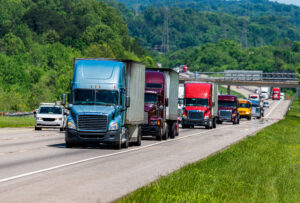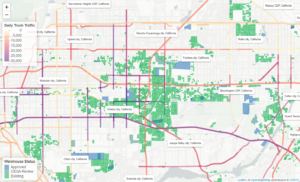
Article by David Mathias and Rachel Supnick
Sitting just east of Los Angeles, the Inland Empire is a metropolitan region consisting of San Bernardino and Riverside counties. It is the 12th largest Metropolitan Statistical Area in the United States by population and has expanded both economically and spatially in part due to its growing logistics industry – consisting mostly of warehousing and associated trucking. This logically follows the region’s geographical advantages: ample land for warehouse development, proximity to the ports of Los Angeles, and access to major railroads and highways that facilitate efficient product transportation. There are 303 warehouses planned and approved to be built by 2025. Along with this growth comes negative externalities such as environmental impacts and infrastructure damage, factors that are often overlooked by a focus on job creation. In this article, we study air quality and road damage.
Figure 1: This map showcases current and planned warehouses and there subsequent truck traffic volumes

PM2.5 – fine particulate matter less than 2.5 micrometers in diameter – poses health risks when appearing in high concentrations in the air. These particles are dangerous due to their ability to penetrate the lung wall and enter the bloodstream. They can cause respiratory problems such as asthma and lead to heart attacks or premature death. In 2023, the cities of Baldwin Park and San Bernardino had the worst levels of PM2.5 in the country.
Trucks release PM2.5 through exhaust. The Robert Redford Conservancy for Southern California Sustainability estimates there are 950,000 heavy-duty truck trips per day in Los Angeles and the Inland Empire alone. These trips emit 1,314 pounds of PM2.5 every day, contributing to the dangerous levels of pollution in the region. The transit of goods in the supply chain also emits high levels of NOx and CO2. Based on 2021 estimates by the California Air Resources Board, one truck trip of about 40 miles emits 2.44 tons of carbon dioxide. This adds up to almost 40,000 tons of carbon dioxide to the atmosphere in Southern California each day, more than twice as many tons produced by the drivers in LA, San Bernardino, and Riverside combined (cars in the three cities release a little less than 17,000 tons of CO2 per day).
Heavy trucks also contribute disproportionately to road wear, decreasing the useful life of a road. A study conducted by The American Association of State Highway Officials (AASHO) reveals that car traffic has an insignificant impact on road damage in comparison to truck traffic. The study notes that road damage scales with vehicle axle weight to the 4th power. This implies that one trip made by a 20,000 pound-per-axle truck would cause road damage equivalent to that of 10,000 trips made by a 2,000-pound-per-axle car. In other words, current and future road damages are strongly associated with truck traffic. Riverside County experiences 8,914 truck trips per day while San Bernardino County experiences 6,807. Of the 366 warehouses planned and approved by 2025, 83% are slated for San Bernardino and Riverside Counties, leading to an expected increase of 868 daily heavy truck trips in Riverside and 453 in San Bernardino. These increases in truck traffic are projected to correspondingly raise the Estimated Axle Load (EAL) – a measure of road damage – with Riverside anticipating an additional 176 EALs and San Bernardino 99. Currently, the average truck route in Riverside withstands 1811 EALs while San Bernardino withstands 1489 EALs.
The financial implications of this infrastructure strain are substantial. Projected increases in EALs could shorten the intended useful life of roads in both counties by up to 10 years. This means that cities will face large road damage costs much sooner than anticipated. Estimates suggest that repaving just one mile of damaged road could cost between $100,000 and $1 million. This projected premature expense will dilute the positive economic impacts that accompany warehouse growth and raises urgent questions about the costs and benefits of warehousing growth.
A group of environmental institutions under the leadership of the Robert Redford Conservancy for Southern California Sustainability submitted an 80-page study to Governor Newsome asking for a two-year moratorium on the expansion of the logistics industry in the Inland Empire. While the governor did not react to the submission, there were several California Assembly Bills (ABs) under consideration which would have halted further expansion of the logistics industry. AB 1000, for example, would have banned new warehouse projects exceeding 100,000 square feet within 1,000 feet of institutions such as schools, churches, prisons and playfields where children, elderly, and others at heightened risk of health problems due to exposure to air pollution congregate. Though the bill was pulled, Attorney General Rob Bonta released a memorandum of “best practices” for constructing warehouses in compliance with the California Environmental Quality Act in September 2022; it included a clear but non-binding recommendation to comply with AB 1,000. AB627 would create the California Hybrid and Zero-Emission Truck and Bus Voucher Incentive Project in which eligible fleets would receive funding to purchase more environmentally friendly trucks, or to refit old ones to stop running on 100% diesel.
As reported in the Los Angeles Times on February 15, the Energy Department has decided to award as much as a $1.2 billion payment for a public-private partnership to create a hydrogen hub in California. Semi-trucks with hydrogen fuel cells are developed by manufacturers and even shipping lines have started to take steps towards hydrogen or methanol powered container ships. In addition, there is the potential for developing heavy rail locomotives that will be hydrogen powered. Still, these developments are years away. In 2023, 0.025% of trucks in San Bernardino and Riverside counties were electric and 1% on natural gas – negligible numbers compared to the remaining 98% running on diesel and gasoline.
That said, the growth of logistics in the Inland Empire has created a significant number of job opportunities in the region. Transportation and warehousing saw the largest employment increase of any industry in the Inland Empire in the last twenty years. Logistics employed 12.3% of the Inland Empire’s labor force in 2023, compared to just 4.4% in 2003 driven by a steady rise in online shopping from less than 2% of retail sales in 2003 to over 15% in 2023. Logistics employment more than doubled from May 2020 to November 2023 with a 119% increase in the number of workers in the industry. These workers are paid an hourly wage of $22.54, on average, which is only 65% of California’s $35.20 per hour average across all industries. Moreover, these jobs can pose a high risk of injury. According to the Department of Labor, the 2021 injury and illness rate in warehouses was 5.5 incidences per 100 workers, more than double the rate of 2.7 incidences per 100 for workers across all industries. These jobs are of lower-than-average quality. Yet they represent an important opportunity for low-skill workers in the Inland Empire, a region whose monthly unemployment rate has averaged 1.8 points higher than the national average over the past 20 years.
As the Inland Empire continues to be a crucial hub for the nation’s logistics industry, the region faces a difficult tradeoff between economic growth and environmental sustainability. Many residents express concern over the rapid expansion of warehouses, as they contribute to increased traffic, pollution, health issues, and urban congestion. Meanwhile, job creation, enhanced city revenues, expanded infrastructure, and a strengthened local supply chain are undeniable benefits. Continued data collection and analysis will be crucial in finding this balance to maintain regional prosperity.
——
“We would like to thank the Robert Redford Conservancy for Southern California Sustainability as well as Mike McCarthy for their support during our research and creation of our map. We would also like to thank Minjae Yun for her help in constructing our map.”
Robert Redford Conservancy of Southern California: https://www.pitzer.edu/redfordconservancy/
Warehouse City: https://radicalresearch.shinyapps.io/WarehouseCITY/
——
Article by
David Mathias ’25 and Rachel Supnick ’26
Economic Journalists
Lowe Institute of Political Economy
